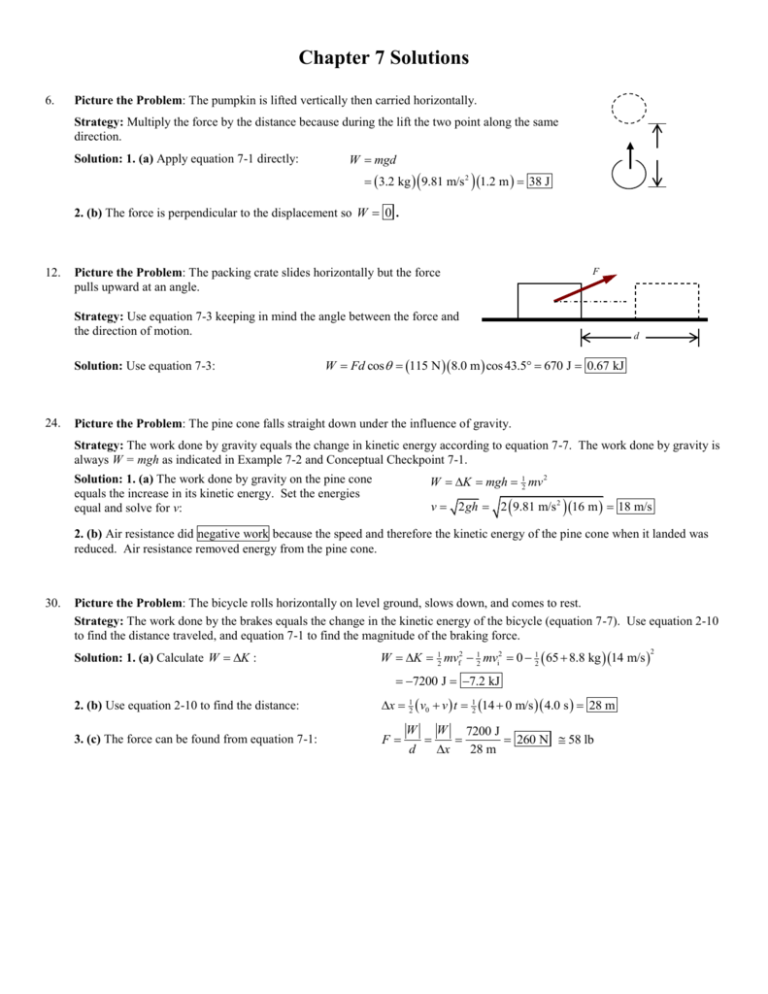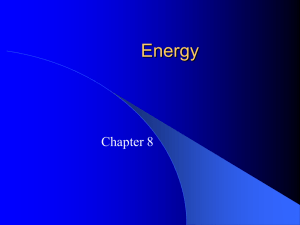Chapter 7 Solutions
advertisement

Chapter 7 Solutions 6. Picture the Problem: The pumpkin is lifted vertically then carried horizontally. Strategy: Multiply the force by the distance because during the lift the two point along the same direction. Solution: 1. (a) Apply equation 7-1 directly: W mgd 3.2 kg 9.81 m/s 2 1.2 m 38 J 2. (b) The force is perpendicular to the displacement so W 0 . 12. F Picture the Problem: The packing crate slides horizontally but the force pulls upward at an angle. Strategy: Use equation 7-3 keeping in mind the angle between the force and the direction of motion. Solution: Use equation 7-3: 24. d W Fd cos 115 N 8.0 m cos 43.5 670 J 0.67 kJ Picture the Problem: The pine cone falls straight down under the influence of gravity. Strategy: The work done by gravity equals the change in kinetic energy according to equation 7-7. The work done by gravity is always W = mgh as indicated in Example 7-2 and Conceptual Checkpoint 7-1. W K mgh 12 mv 2 Solution: 1. (a) The work done by gravity on the pine cone equals the increase in its kinetic energy. Set the energies equal and solve for v: v 2 gh 2 9.81 m/s 2 16 m 18 m/s 2. (b) Air resistance did negative work because the speed and therefore the kinetic energy of the pine cone when it landed was reduced. Air resistance removed energy from the pine cone. 30. Picture the Problem: The bicycle rolls horizontally on level ground, slows down, and comes to rest. Strategy: The work done by the brakes equals the change in the kinetic energy of the bicycle (equation 7-7). Use equation 2-10 to find the distance traveled, and equation 7-1 to find the magnitude of the braking force. Solution: 1. (a) Calculate W K : W K 12 mvf2 12 mvi2 0 12 65 8.8 kg 14 m/s 7200 J 7.2 kJ 2. (b) Use equation 2-10 to find the distance: x 3. (c) The force can be found from equation 7-1: F 1 2 v0 v t 12 14 0 m/s 4.0 s W d W x 28 m 7200 J 260 N 58 lb 28 m 2 34. Picture the Problem: The block slides toward the right and into the spring. After compressing the spring the block comes to rest. Strategy: The work to stretch or compress a spring a distance x is 12 kx2 . The work done on the block by the spring equals the kinetic energy lost by the block. The work done on the block is negative because the force on the block is toward the left while the motion is toward the right. Solution: 1. Apply equations 7-7 and 7-8: Won block Kblock 0 12 mvi2 12 kx2 2. Now solve for k: k m 2.2 m/s vi2 1.8 kg 91 N/m 2 2 x 0.31 m 2 38. Picture the Problem: The springs are stretched horizontally in each case. Strategy: The works and stretch distances can be used to find the spring constants by applying equation 7-8. Solution: 1. Solve equation 7-8 for k1 : k1 2 150 J 2W1 2 2 x1 0.20 m 7500 N/m 2. Solve equation 7-8 for k2 : k2 2 210 J 2W2 4700 N/m 2 2 x2 0.30 m 3. Stiffer springs have larger spring constants so we conclude spring 1 is stiffer. 46. Picture the Problem: The microwave oven delivers energy to the ice cube via electromagnetic waves. Strategy: The power required is the energy delivered divided by the time. Solution: Solve equation 7-10 for t: 48. t W 32200 J 307 s 5.11 min P 105 W Picture the Problem: The water is pumped vertically upward. Strategy: The power required is the work required to change the elevation divided by the time. As in Conceptual Checkpoint 71 and Example 7-2 the work required to change the elevation of an object is W mgh. Solution: Divide the work required by the time: P W mgh 12.0 lb 4.448 N/lb 2.00 m t t 1.00 s P 107 W 1 hp 746 W 0.143 hp





